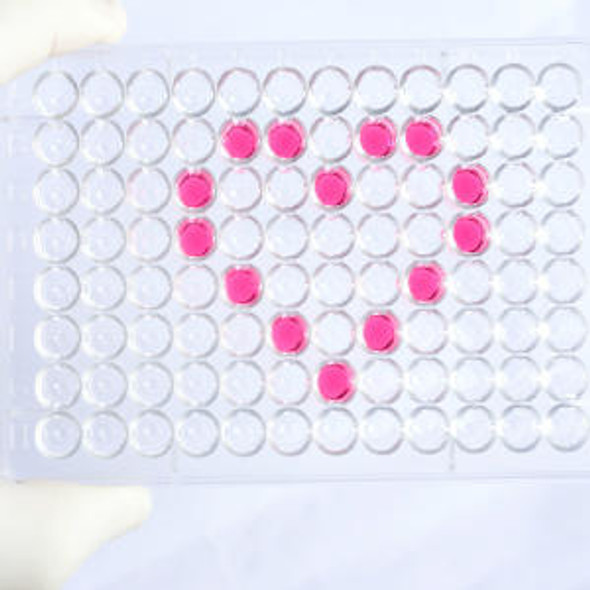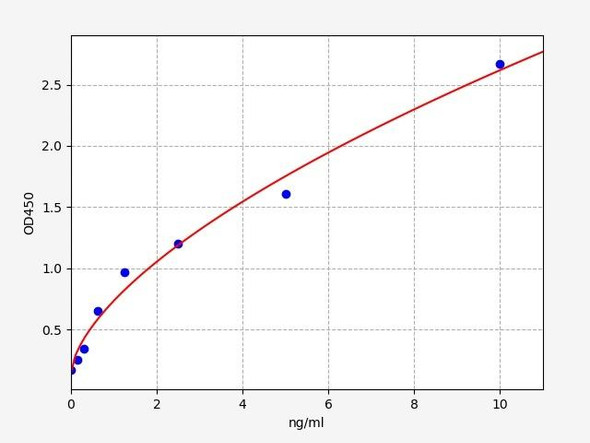Description
Human WNT3 (Proto-oncogene Wnt-3) ELISA Kit (HUFI05640)
The Human WNT3 Proto-Oncogene (WNT-3) ELISA Kit from Assay Genie is specifically designed for the detection of WNT-3 levels in human serum, plasma, and cell culture supernatants. With high sensitivity and specificity, this kit delivers reliable and reproducible results, making it ideal for a wide range of research applications.The WNT3 proto-oncogene is a key player in cell signaling pathways, influencing cell growth, differentiation, and development. Dysregulation of WNT-3 expression has been associated with various diseases, including cancer and developmental disorders.
Therefore, the accurate measurement of WNT-3 levels is crucial for understanding its role in disease pathology and exploring potential therapeutic interventions.With the Human WNT3 Proto-Oncogene (WNT-3) ELISA Kit, researchers can confidently assess WNT-3 levels in biological samples, advancing their studies in cancer biology, developmental biology, and beyond. Trust Assay Genie for precise and reliable results in your research endeavors.
| Product Name: | Human WNT3 (Proto-oncogene Wnt-3) ELISA Kit |
| Product Code: | HUFI05640 |
| Size: | 96 Assays |
| Alias: | WNT3 ELISA Kit |
| Detection method: | Sandwich ELISA, Double Antibody |
| Application: | This immunoassay kit allows for the in vitro quantitative determination of Human WNT3 (Proto-oncogene Wnt-3) concentrations in serum plasma and other biological fluids. |
| Sensitivity: | < 0.094ng/ml |
| Range: | 0.156-10ng/ml |
| Storage: | 4°C for 6 months |
| Note: | For Research Use Only |
| Recovery: | Matrices listed below were spiked with certain level of Human WNT3 (Proto-oncogene Wnt-3) and the recovery rates were calculated by comparing the measured value to the expected amount of Human WNT3 (Proto-oncogene Wnt-3) in samples. Enquire for more information. |
| Linearity: | The linearity of the kit was assayed by testing samples spiked with appropriate concentration of Human WNT3 (Proto-oncogene Wnt-3) and their serial dilutions. The results were demonstrated by the percentage of calculated concentration to the expected. Enquire for more information. |
| CV(%): | Intra-Assay: CV<8% Inter-Assay: CV<10% |
| Component | Quantity | Storage |
| ELISA Microplate (Dismountable) | 8×12 strips | 4°C for 6 months |
| Lyophilized Standard | 2 | 4°C/-20°C |
| Sample/Standard Dilution Buffer | 20ml | 4°C |
| Biotin-labeled Antibody(Concentrated) | 120ul | 4°C (Protect from light) |
| Antibody Dilution Buffer | 10ml | 4°C |
| HRP-Streptavidin Conjugate(SABC) | 120ul | 4°C (Protect from light) |
| SABC Dilution Buffer | 10ml | 4°C |
| TMB Substrate | 10ml | 4°C (Protect from light) |
| Stop Solution | 10ml | 4°C |
| Wash Buffer(25X) | 30ml | 4°C |
| Plate Sealer | 5 | - |
Other materials and equipment required:
- Microplate reader with 450 nm wavelength filter
- Multichannel Pipette, Pipette, microcentrifuge tubes and disposable pipette tips
- Incubator
- Deionized or distilled water
- Absorbent paper
- Buffer resevoir
| UniProt Protein Function: | WNT3: Ligand for members of the frizzled family of seven transmembrane receptors. Wnt-3 and Wnt-3a play distinct roles in cell-cell signaling during morphogenesis of the developing neural tube. Defects in WNT3 are the cause of autosomal recessive tetra-amelia (ARTTRA). Tetra-amelia is a rare human genetic disorder characterized by complete absence of all four limbs and other anomalies such as craniofacial, nervous system, pulmonary, skeletal and urogenital defects. Belongs to the Wnt family. |
| UniProt Protein Details: | Protein type:Secreted; Oncoprotein; Secreted, signal peptide Chromosomal Location of Human Ortholog: 17q21 Cellular Component: extracellular space; proteinaceous extracellular matrix; Golgi lumen; endoplasmic reticulum lumen; extracellular region; plasma membrane Molecular Function:protein domain specific binding; protein binding; frizzled binding; receptor agonist activity Biological Process: embryonic forelimb morphogenesis; axon guidance; cell fate commitment; cell morphogenesis; dorsal/ventral axis specification; Wnt receptor signaling pathway through beta-catenin; positive regulation of collateral sprouting in the absence of injury; negative regulation of axon extension involved in axon guidance; embryonic hindlimb morphogenesis; Spemann organizer formation at the anterior end of the primitive streak; neuron differentiation; limb bud formation; mesoderm formation; gamete generation; anterior/posterior axis specification Disease: Tetraamelia, Autosomal Recessive |
| NCBI Summary: | The WNT gene family consists of structurally related genes which encode secreted signaling proteins. These proteins have been implicated in oncogenesis and in several developmental processes, including regulation of cell fate and patterning during embryogenesis. This gene is a member of the WNT gene family. It encodes a protein which shows 98% amino acid identity to mouse Wnt3 protein, and 84% to human WNT3A protein, another WNT gene product. The mouse studies show the requirement of Wnt3 in primary axis formation in the mouse. Studies of the gene expression suggest that this gene may play a key role in some cases of human breast, rectal, lung, and gastric cancer through activation of the WNT-beta-catenin-TCF signaling pathway. This gene is clustered with WNT15, another family member, in the chromosome 17q21 region. [provided by RefSeq, Jul 2008] |
| UniProt Code: | P56703 |
| NCBI GenInfo Identifier: | 13540477 |
| NCBI Gene ID: | 7473 |
| NCBI Accession: | NP_110380.1 |
| UniProt Secondary Accession: | P56703,Q2M237, Q9H1J9, |
| UniProt Related Accession: | P56703 |
| Molecular Weight: | 39,645 Da |
| NCBI Full Name: | proto-oncogene Wnt-3 |
| NCBI Synonym Full Names: | Wnt family member 3 |
| NCBI Official Symbol: | WNT3 |
| NCBI Official Synonym Symbols: | INT4; TETAMS |
| NCBI Protein Information: | proto-oncogene Wnt-3 |
| UniProt Protein Name: | Proto-oncogene Wnt-3 |
| UniProt Synonym Protein Names: | Proto-oncogene Int-4 homolog |
| Protein Family: | Proto-oncogene |
| UniProt Gene Name: | WNT3 |
| UniProt Entry Name: | WNT3_HUMAN |
*Note: Protocols are specific to each batch/lot. For the correct instructions please follow the protocol included in your kit.
Before adding to wells, equilibrate the SABC working solution and TMB substrate for at least 30 min at 37 °C. When diluting samples and reagents, they must be mixed completely and evenly. It is recommended to plot a standard curve for each test.
| Step | Protocol |
| 1. | Set standard, test sample and control (zero) wells on the pre-coated plate respectively, and then, record their positions. It is recommended to measure each standard and sample in duplicate. Wash plate 2 times before adding standard, sample and control (zero) wells! |
| 2. | Aliquot 0.1ml standard solutions into the standard wells. |
| 3. | Add 0.1 ml of Sample / Standard dilution buffer into the control (zero) well. |
| 4. | Add 0.1 ml of properly diluted sample ( Human serum, plasma, tissue homogenates and other biological fluids.) into test sample wells. |
| 5. | Seal the plate with a cover and incubate at 37 °C for 90 min. |
| 6. | Remove the cover and discard the plate content, clap the plate on the absorbent filter papers or other absorbent material. Do NOT let the wells completely dry at any time. Wash plate X2. |
| 7. | Add 0.1 ml of Biotin- detection antibody working solution into the above wells (standard, test sample & zero wells). Add the solution at the bottom of each well without touching the side wall. |
| 8. | Seal the plate with a cover and incubate at 37 °C for 60 min. |
| 9. | Remove the cover, and wash plate 3 times with Wash buffer. Let wash buffer rest in wells for 1 min between each wash. |
| 10. | Add 0.1 ml of SABC working solution into each well, cover the plate and incubate at 37 °C for 30 min. |
| 11. | Remove the cover and wash plate 5 times with Wash buffer, and each time let the wash buffer stay in the wells for 1-2 min. |
| 12. | Add 90 µL of TMB substrate into each well, cover the plate and incubate at 37 °C in dark within 10-20 min. (Note: This incubation time is for reference use only, the optimal time should be determined by end user.) And the shades of blue can be seen in the first 3-4 wells (with most concentrated standard solutions), the other wells show no obvious color. |
| 13. | Add 50 µL of Stop solution into each well and mix thoroughly. The color changes into yellow immediately. |
| 14. | Read the O.D. absorbance at 450 nm in a microplate reader immediately after adding the stop solution. |
When carrying out an ELISA assay it is important to prepare your samples in order to achieve the best possible results. Below we have a list of procedures for the preparation of samples for different sample types.
| Sample Type | Protocol |
| Serum | If using serum separator tubes, allow samples to clot for 30 minutes at room temperature. Centrifuge for 10 minutes at 1,000x g. Collect the serum fraction and assay promptly or aliquot and store the samples at -80°C. Avoid multiple freeze-thaw cycles. If serum separator tubes are not being used, allow samples to clot overnight at 2-8°C. Centrifuge for 10 minutes at 1,000x g. Remove serum and assay promptly or aliquot and store the samples at -80°C. Avoid multiple freeze-thaw cycles. |
| Plasma | Collect plasma using EDTA or heparin as an anticoagulant. Centrifuge samples at 4°C for 15 mins at 1000 × g within 30 mins of collection. Collect the plasma fraction and assay promptly or aliquot and store the samples at -80°C. Avoid multiple freeze-thaw cycles. Note: Over haemolysed samples are not suitable for use with this kit. |
| Urine & Cerebrospinal Fluid | Collect the urine (mid-stream) in a sterile container, centrifuge for 20 mins at 2000-3000 rpm. Remove supernatant and assay immediately. If any precipitation is detected, repeat the centrifugation step. A similar protocol can be used for cerebrospinal fluid. |
| Cell culture supernatant | Collect the cell culture media by pipette, followed by centrifugation at 4°C for 20 mins at 1500 rpm. Collect the clear supernatant and assay immediately. |
| Cell lysates | Solubilize cells in lysis buffer and allow to sit on ice for 30 minutes. Centrifuge tubes at 14,000 x g for 5 minutes to remove insoluble material. Aliquot the supernatant into a new tube and discard the remaining whole cell extract. Quantify total protein concentration using a total protein assay. Assay immediately or aliquot and store at ≤ -20 °C. |
| Tissue homogenates | The preparation of tissue homogenates will vary depending upon tissue type. Rinse tissue with 1X PBS to remove excess blood & homogenize in 20ml of 1X PBS (including protease inhibitors) and store overnight at ≤ -20°C. Two freeze-thaw cycles are required to break the cell membranes. To further disrupt the cell membranes you can sonicate the samples. Centrifuge homogenates for 5 mins at 5000xg. Remove the supernatant and assay immediately or aliquot and store at -20°C or -80°C. |
| Tissue lysates | Rinse tissue with PBS, cut into 1-2 mm pieces, and homogenize with a tissue homogenizer in PBS. Add an equal volume of RIPA buffer containing protease inhibitors and lyse tissues at room temperature for 30 minutes with gentle agitation. Centrifuge to remove debris. Quantify total protein concentration using a total protein assay. Assay immediately or aliquot and store at ≤ -20 °C. |
| Breast Milk | Collect milk samples and centrifuge at 10,000 x g for 60 min at 4°C. Aliquot the supernatant and assay. For long term use, store samples at -80°C. Minimize freeze/thaw cycles. |









